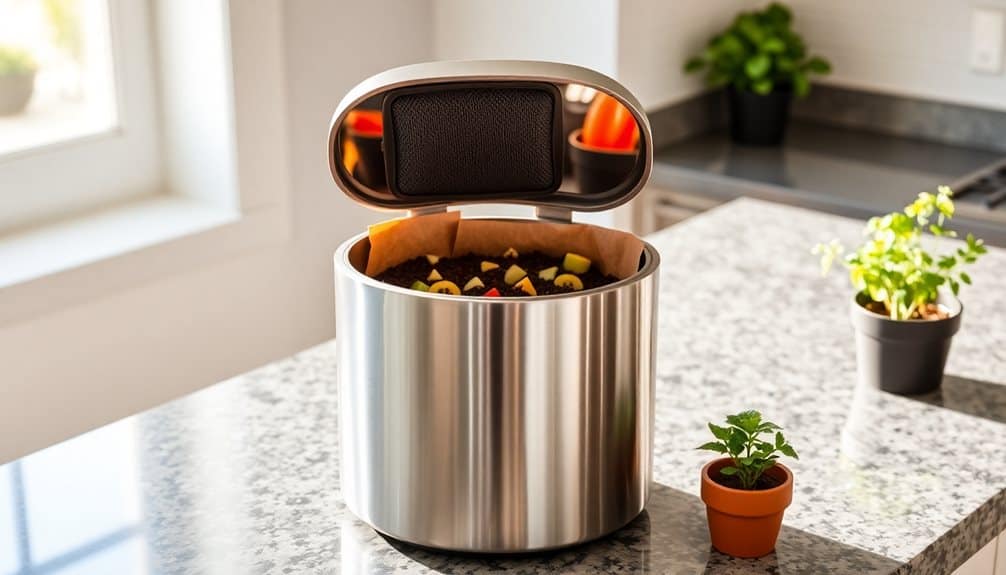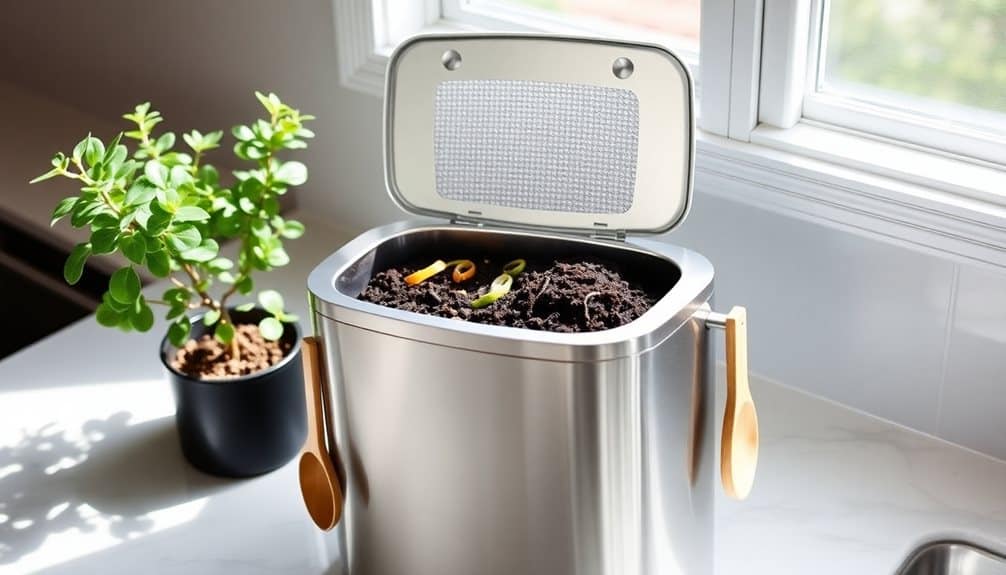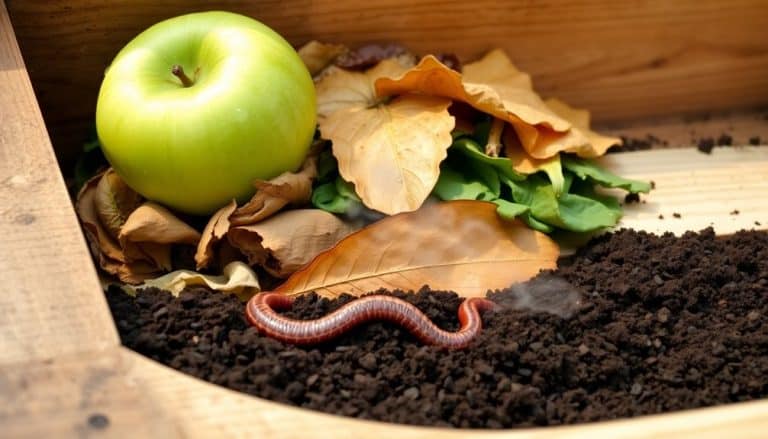This website contains affiliate links. Some products are gifted by the brand to test. As an Amazon Associate, I earn from qualifying purchases. The content on this website was created with the help of AI.
You’ll find several excellent indoor composting options for your small apartment, from electric systems to traditional bins. For a high-tech solution, consider the Food Cycler FC-30, which reduces waste by 90% in hours, or the more affordable Vitamix FoodCycler FC-50. If you’re on a budget, the Joseph Joseph Stack 4 ($35) or OXO Good Grips bin ($20) offer reliable traditional composting with odor control. For ultra-compact spaces, try the Bokashi One system, which fits under your sink and uses fermentation. The key is matching the bin to your space constraints and waste output – there’s an ideal system waiting to transform your kitchen scraps into nutrient-rich compost.
Key Takeaways
- The Vitamix FoodCycler FC-50 offers rapid composting in a compact 12.6 x 11-inch size, ideal for small apartments.
- The Bokashi One system fits under kitchen sinks and uses fermentation to process food waste efficiently at $89.
- OXO Good Grips Compost Bin provides affordable odor control with a 0.75-gallon capacity and tight-sealing lid for $20.
- The Utopia Kitchen Countertop bin’s slim 7.16-inch diameter design maximizes space while maintaining practical composting capacity.
- Joseph Joseph Stack 4 employs multi-layer filtration in a space-efficient design for $35, suitable for limited counter space.
Understanding Indoor Composting Basics

For successful indoor composting, you’ll need to understand the core principles that transform kitchen scraps into nutrient-rich soil. The process relies on maintaining a balanced mix of “green” materials (nitrogen-rich items like fruit and vegetable scraps, coffee grounds) and “brown” materials (carbon-rich items like dried leaves, paper, or cardboard). You’ll want to maintain a ratio of roughly 3:1 brown to green materials.
Proper moisture levels are essential – your compost should feel like a wrung-out sponge. Too much moisture leads to anaerobic conditions and unpleasant odors, while too little slows down decomposition. Temperature control isn’t as important for indoor systems as it is for outdoor ones, but you’ll still need to guarantee adequate air circulation to support aerobic decomposition.
The key to odor-free indoor composting lies in proper management. Don’t add meat, dairy, or oily foods, as these can attract pests and create offensive smells. Instead, focus on plant-based kitchen scraps, coffee grounds, and tea bags. Regularly turning your compost helps distribute moisture and oxygen, speeding up the decomposition process while preventing unwanted odors. For optimal results, consider that most fruit and vegetable scraps will fully decompose within 2-4 weeks when properly maintained.
Top Composting Bins Reviews

Now that you understand the fundamentals of indoor composting, let’s examine the most effective bins available for your apartment setup. The Food Cycler FC-30 leads the market with its electric composting system that reduces food waste by 90% in just 4-8 hours, making it ideal for spaces under 1,000 square feet. It’s virtually odorless but comes with a higher price point at $300-400.
For a more affordable option, the Vitamix FoodCycler FC-50 offers similar performance at around $200 while maintaining a compact 12.6 x 11-inch footprint. The Bokashi One system ($89) uses beneficial microorganisms to ferment your waste, fitting neatly under most kitchen sinks.
If you’re seeking a traditional composting method, the Joseph Joseph Stack 4 ($35) features a multi-layer filtration system and activated charcoal filters that effectively contain odors. For countertop collection, the OXO Good Grips Compost Bin ($20) holds 0.75 gallons of scraps with a tight-sealing lid and smooth interior walls that prevent food from sticking. Both options integrate seamlessly into small kitchen spaces while maintaining aesthetic appeal and functionality. Regular annual inspections are essential to ensure your composting bin maintains optimal performance and structural integrity over time.
Size and Space Considerations

When choosing an indoor composting system, space optimization becomes paramount in apartment living. You’ll need to measure your available space carefully, considering both horizontal and vertical dimensions. Most countertop bins require about one cubic foot of space, while under-sink systems might need up to two cubic feet.
For micro-apartments under 500 square feet, you’ll want to focus on compact solutions that serve multiple functions. Wall-mounted systems can maximize vertical space, while stackable bins work well in utility closets. Consider bins that fit seamlessly into existing storage areas, such as under the kitchen sink or inside cabinet doors.
The key is to match your bin’s capacity with your household’s food waste output. A single person typically produces 2-3 pounds of compostable waste weekly, requiring a minimum 1-gallon container. For two people, you’ll need at least a 2-gallon system. Remember to factor in space for additional materials like brown matter and any tools you’ll need for maintenance. Some modular systems allow you to expand capacity gradually, making them ideal for flexible living situations where space availability might change. The Utopia Kitchen Countertop bin offers an excellent space-saving solution with its modest 7.16-inch diameter and 11-inch height dimensions.
Maintenance and Odor Control

Proper maintenance stands at the heart of successful indoor composting, particularly when it comes to managing potential odors in small spaces. You’ll need to maintain a balanced ratio of green (nitrogen-rich) to brown (carbon-rich) materials, typically following a 1:3 ratio. Regular monitoring of moisture levels is essential – your compost should feel like a wrung-out sponge, not soggy or dry.
To control odors effectively, you’ll want to turn your compost every 3-4 days using a small pitchfork or mixing tool. This aerates the mixture and accelerates decomposition. Adding a layer of brown materials like shredded paper or dried leaves after each food deposit helps absorb excess moisture and minimize smells. If you notice any unpleasant odors, it’s usually a sign that your mix is too wet or lacks enough brown materials.
Consider keeping a container of baking soda near your bin to absorb ambient odors, and clean the bin’s edges weekly with vinegar solution. You’ll also want to harvest finished compost promptly – when it’s dark, crumbly, and earth-smelling – to prevent overloading and maintain ideal functioning. Using a quality compost sifter will help separate the finished material from larger chunks that need more time to break down.
Vermicomposting for Small Spaces

Vermicomposting offers an efficient, space-saving solution for apartment dwellers who want to recycle food scraps into nutrient-rich soil. Using red wiggler worms (Eisenia fetida), you can transform your kitchen waste into high-quality compost in a compact bin that fits under your sink or in a closet.
To start vermicomposting, you’ll need a well-ventilated bin with drainage holes, bedding material like shredded paper or coconut coir, and about one pound of composting worms. The worms will consume roughly half their weight in food scraps daily, converting waste into worm castings – a potent organic fertilizer rich in beneficial microorganisms and plant nutrients.
You can feed your worms fruit and vegetable scraps, coffee grounds, and eggshells, but avoid meat, dairy, oils, and acidic foods. Maintain proper moisture levels by keeping the bedding as damp as a wrung-out sponge, and guarantee temperatures stay between 55-77°F (13-25°C). When managed correctly, a vermicomposting system produces minimal odor and requires only 15 minutes of maintenance per week, making it an ideal solution for eco-conscious apartment living. For an alternative composting method, consider using a bokashi system which can process a wider variety of food waste, including meat and dairy products.
Frequently Asked Questions
Can I Compost if My Apartment Building Restricts Electrical Appliances?
Don’t let electrical restrictions dim your earth-saving spirit! You can absolutely compost without power using traditional methods. Try a manual countertop bin with activated charcoal filters, or go for a bokashi system that ferments waste through natural processes. These methods are silent, energy-free, and just as effective. Remember to layer your browns and greens, and you’ll create black gold for plants without any plugs.
What Happens to My Compost System During Extended Vacations?
When you’re away for extended periods, your compost system needs attention to prevent odors and maintain decomposition. Before leaving, add extra brown materials (like dried leaves or paper) to slow moisture buildup. You can also freeze food scraps until you return, or temporarily pause collecting new materials. If you’ll be gone for weeks, consider asking a neighbor to monitor moisture levels or transfer your active compost to a community garden.
Will Indoor Composting Affect My Home Insurance Policy?
You’ll want to check with your insurance provider about how indoor composting affects your policy. While most standard policies don’t specifically mention composting, they do cover damage from moisture, odors, or pests – potential issues that could arise from improper composting. It’s smart to document your composting setup, follow manufacturer guidelines, and maintain proper moisture levels to prevent any issues that could impact your coverage.
Can Composting Bins Be Used on Carpeted Floors?
You’ll want to avoid placing composting bins directly on carpeted floors due to potential moisture issues and staining. Instead, use a protective mat or tray underneath your bin to create a waterproof barrier. Consider elevating your bin on a sturdy platform to improve airflow and prevent any seepage from damaging your carpet. This setup protects your flooring while maintaining an efficient composting system.
Do Indoor Composting Bins Require Special Permits in Residential Buildings?
While 95% of US cities don’t require permits for indoor composting, you’ll want to check your local regulations and building policies. Most residential buildings allow small-scale composting, but you should review your lease agreement and notify your property manager. If you’re part of a homeowners association (HOA), their bylaws might have specific rules about composting activities. When in doubt, contact your local waste management department for guidance.




